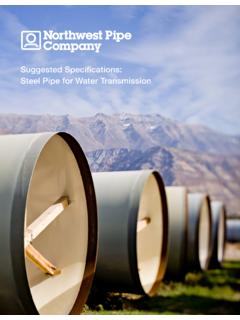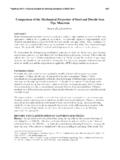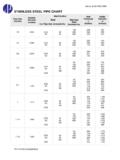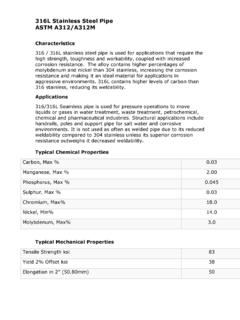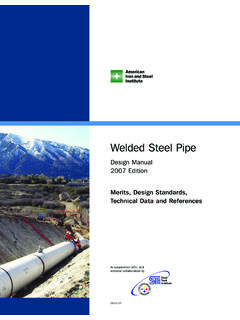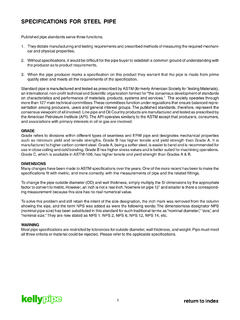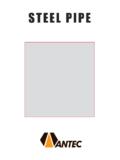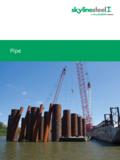Transcription of Revision of the AWWA C200 Steel Water Pipe …
1 Revision of the awwa c200 Steel Water pipe Manufacturing Standard: Consensus-Based Changes Mark Significant Improvements John H. Bambei, Jr., , , Brent Keil, , 1 Chair- awwa Standards Committee on Steel pipe , Chief of Engineering, Denver Water , 1600 West 12th Avenue, Denver, CO 80204, Tel: (303) 628-6669, e-mail: 2 Chief Engineer, Northwest pipe Company, 5712 SE Columbia Way, Suite 200, Vancouver, WA 98661, Tel: (360) 397-6250, e-mail: ABSTRACT awwa c200 Steel Water pipe , 6 Inch and Larger, is an industry consensus standard that is recognized throughout the world and is the preeminent guide for the manufacture of Steel pipe for Water and wastewater applications in North America. The first awwa Steel Water pipe standards, and were published in 1940.
2 In 1949, was replaced with C201 and was replaced with C202. These two standards were later combined into the c200 standard in 1975. Since then, the document has undergone six revisions, each iteration marked by improvements to the manufacturing process as well as associated quality control procedures. The most recent Revision , incorporating a number of significant updates, was approved by the awwa Board of Directors on June 22, 2012 and became effective on September 1, 2012. This paper will provide a historical perspective of awwa Steel Water pipe standards, followed by a discussion of some substantial improvements made in the latest Revision of c200 . Topics discussed will include considerations for the Charpy toughness or impact testing, new testing requirements for gasket materials, allowable Steel grades and or characteristics, manufacturing test requirements, weld procedures and weld testing.
3 HISTORY OF awwa Steel Water pipe STANDARDS Steel Water pipe standards have been around in one form or another since the early installations of the product near the turn of the previous century. The following is a brief history of Steel Water pipe and the standards that eventually governed its manufacture. History of Steel Water pipe A history of Steel Water pipe in the US can be found in awwa M11 (2004) as well as other documents written on the subject. Cates (1971) discusses wrought iron pipes being developed and installed in the early nineteenth century. Later with the advent of the Bessemer process in the 1850 s, the Age of Steel was born. The Bessemer process reduced the carbon content of molten iron and removed impurities to form Steel and also allowed for the mass production that previously was unobtainable.
4 This allowed industry to tap into the superior properties of Steel that had been difficult and expensive to obtain previously. During this same period the first Steel Water pipes were manufactured and installed in the US, with the first recorded installation in 1858 (Cates 1971). 398 Pipelines 2013 ASCE 2013 The first Steel pipe used rivets to join the seams (see Figure 1). This process was improved over the years and was common practice through the 1930 s. Around that time the improvements to the process of welding started to make it the preferred choice to join pipe seams together, although field joints were still typically riveted as portable welding equipments was not common. Figure 1 : Riveted Steel pipe Joint Another joining method that was developed in 1905 gained popularity up through the common use of welding in pipe manufacturing.
5 Called Lock-Bar pipe (see Figure 2), it used H shaped bars to joint two half circle Steel plates with upset edges together by hydraulic pressure. , The joint was considered to be 100% efficient and therefore quickly gained acceptance. By the mid 1920 s Lock Bar had taken on a major role in the industry, but as with riveted pipe was eventually replaced by welding. Figure 2 : Lock-Bar pipe Joint Helically welded Steel pipe was developed in the 1930 s and was used extensively in diameters of 4 through 36 inch. After WWII German technology was brought to the US, helically welded diameters through 144 inch became possible (see Figure 3). 399 Pipelines 2013 ASCE 2013 Figure 3 : Spiral Welded Steel pipe , 126 Diameter (During Hydrotest) Steel pipelines produced to the original awwa Steel Water pipe standards are still serving admirably in Water systems today.
6 Over the subsequent years since the publication of the first awwa Steel Water pipe standard, welding and forming technology has improved considerably, as has Steel production and coatings. The improvements incorporated in the awwa Standards of today give the industry Steel Water pipe that is unmatched in quality and durability by previous generations. Predecessors of awwa c200 Before the first published standard for Steel Water pipe by awwa , other standardization agencies such as Underwriter Laboratories (1938) were already writing Steel Water pipe standards. In 1939 however a committee A7A, the Steel Plate pipe Committee of the American Water Works Association was formed, the predecessor of awwa Standards Committee on Steel pipe .
7 At the same time a subsidiary group, the Steel Water pipe Technical Advisory Committee (now known as SWPMTAC, the Steel Water pipe Manufacturers Technical Advisory Committee) was formed as a technical information source for the parent committee and is still very active today. Committee A7A was succeeded by 8310D, the Water Works Practice Committee, and then the current awwa Standard Committee on Steel pipe . This committee is currently responsible for 25 Standards and one manual relating to Steel pipe , including awwa c200 . In 1940 and 1941 two Steel pipe standards were published, awwa Standard (1940) (see Figure 4), Electric Fusion Welded Steel Water pipe Of Sizes 30 Inches And Over and awwa Standard (1941) (see Figure 5) Steel Water pipe Of Sizes 4 Inches Up To But Not Including 30 Inches.
8 The main differences between the standards can be seen in their respective scopes. The scope of awwa states: These specifications cover the manufacture of straight seam or spiral seam electric fusion welded Steel pipe , intended for the conveyance of Water , which is thirty (30) inches and greater in diameter and is in twenty (20) feet and longer laying length straight sections or other special sections which are required for closures, curves, changes in alignment or grade to meet special conditions. The contractor, as bidder, shall submit to the 400 Pipelines 2013 ASCE 2013 purchaser the details of the procedure he proposes to use in the fabrication of the pipe and special sections and the procedure shall comply with specifications given hereinafter.
9 The scope of awwa states in part: These specifications cover Steel pipe intended for the conveyance of Water , in sizes of 4 inches up to but not including 30 inches in diameter, and in random, double random or specified laying lengths, straight sections, or other special sections which are required for closures, curves, changes in alignment or grade to meet special conditions and with ends prepared for type of joint specified. The manufacturer or bidder shall state to the purchaser the type of pipe manufacture he proposes to use in the production of mill pipe or details of the procedure he proposes to use in the manufacture of fabricated pipe and special sections. This manufacturing procedure shall comply with the specifications given hereinafter unless otherwise agreed to by the engineer, purchaser, or authorized inspector during the progress of the work.
10 I Figure 4 : awwa 40 Figure 5 : awwa - 41 The contents of these standards were in many ways similar to that of the c200 standard today. They discussed manufacturing tolerances, weld testing, fitting manufacture, and hydrotesting of pipe . They also included some limited language on coating of Steel pipe . Steels in the two standards were listed differently. In the Steel was specified as ASTM A283 latest Revision , Specification for Low and Intermediate Tensile Strength Carbon Steel Plates. In the Steel was split into mill pipe and fabricated pipe . For fabricated pipe ASTM standard A78 Grade B latest Revision , Low Tensile Strength Carbon- Steel 401 Pipelines 2013 ASCE 2013 Plates of Structural Quality for Welding was specified.
